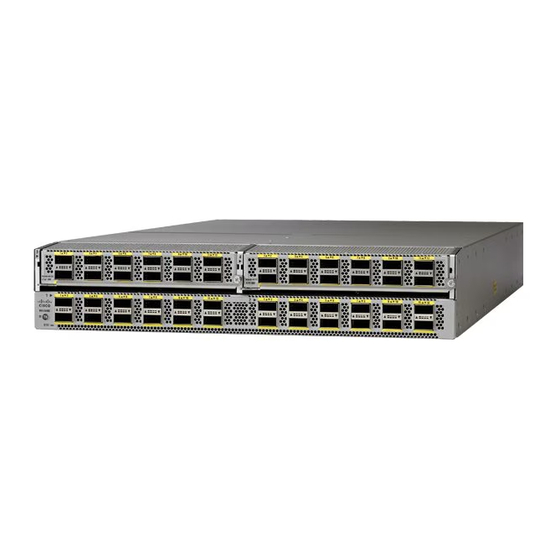
Cisco Nexus 5000 Series Troubleshooting Manual
Hide thumbs
Also See for Nexus 5000 Series:
- Cli configuration manual (660 pages) ,
- Configuration manual (334 pages) ,
- Command reference manual (196 pages)
Table of Contents
Advertisement
Quick Links
S e n d d o c u m e n t c o m m e n t s t o n e x u s 5 k - d o c f e e d b a c k @ c i s c o . c o m .
Troubleshooting System Management Issues
The system management features of the Cisco Nexus 5000 Series switch allow you to monitor and
manage your network for efficient device use, role-based access control, SNMP communications,
diagnostics, and logging.
This chapter describes how to identify and resolve problems that can occur with system management and
the Cisco Nexus 5000 Series switch.
This chapter includes the following sections:
•
•
•
•
•
SNMP
SNMP memory usage continuously increasing
The show proc mem | inc snmp command shows continuously increasing SNMP memory usage.
Possible Cause
SNMP memory usage increases when SNMP requests are processed from different monitoring stations.
Typically, this situation stabilizes over time. If the memory increases continuously without stabilizing,
then some of the SNMP requests are causing a memory leak.
Solution
Review the output from the show system internal snmp mem-stats detail command.
Take example snapshots with the following commands while processing SNMP requests:
•
•
•
OL-25300-01
SNMP
show clock
show system internal mem-stats detail
show tech snmp
1
C H A P T E R
Cisco Nexus 5000 Series Troubleshooting Guide
1-1
Advertisement
Table of Contents

Summary of Contents for Cisco Nexus 5000 Series
- Page 1 C H A P T E R Troubleshooting System Management Issues The system management features of the Cisco Nexus 5000 Series switch allow you to monitor and manage your network for efficient device use, role-based access control, SNMP communications, diagnostics, and logging.
- Page 2 The SNMP community does not have write permission. Solution Check the output of the show snmp community command to ensure that the write permission is enabled. Example: Community Group / Access context acl_filter Cisco Nexus 5000 Series Troubleshooting Guide OL-25300-01...
- Page 3 Although the syslog server is configured, the destination syslog server is not receiving messages from DUT. Possible Cause Syslog server might not be accessible or the logging level might not be appropriate. Solution Cisco Nexus 5000 Series Troubleshooting Guide OL-25300-01...
- Page 4 Check that the appropriate logging level is enabled to send logging messages. Use the show logging • info command. If the logging level is not appropriate, then set the appropriate level using the logging level <feature> <log-level> command. Cisco Nexus 5000 Series Troubleshooting Guide OL-25300-01...
- Page 5 60 seconds, 60 minutes, 72 hours. Viewing the CPU history is valuable when correlating a network event with the past CPU utilization. Cisco NX-OS takes advantage of preemptive CPU multitasking, so processes can take advantage of an idle CPU to complete tasks faster. Therefore the show process cpu history command might display CPU spikes that are not necessarily a problem.
- Page 6 <address1 [address2... address6]> • ip domain-name name [use-vrf <vrf-name>] • ip domain-list name [use-vrf <vrf-name>] • ip name-server <server-address1 [server-address2... server-address6]>< [use-vrf vrf-name>] ip domain lookup • show hosts • copy running-config startup-config • Cisco Nexus 5000 Series Troubleshooting Guide OL-25300-01...
- Page 7 Then you must add back the temporarily removed domains to the domain-list. An alternative approach is to copy the startup-config and delete the desired domain with a text editor. • Then you must load the edited startup-config back onto the device. Cisco Nexus 5000 Series Troubleshooting Guide OL-25300-01...
- Page 8 S e n d d o c u m e n t c o m m e n t s t o n e x u s 5 k - d o c f e e d b a c k @ c i s c o . c o m . Cisco Nexus 5000 Series Troubleshooting Guide...















Need help?
Do you have a question about the Nexus 5000 Series and is the answer not in the manual?
Questions and answers